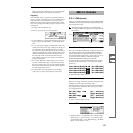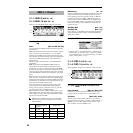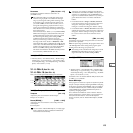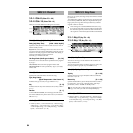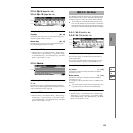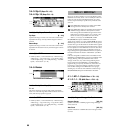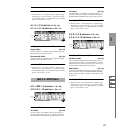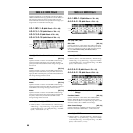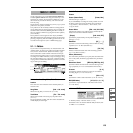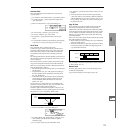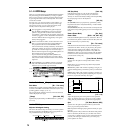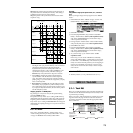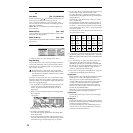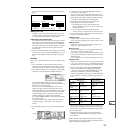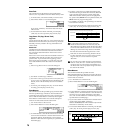
69
SEQ
1.1
1.22.12.23.13.23.33.44.14.24.34.45.15.26.17.17.2
On this instrument you can use preset patterns P000–149,
and user patterns U00–99. One song can contain up to one
hundred user patterns. Preset patterns suitable for use in a
drum track are provided in memory, and can be selected
from any song.
Preset patterns cannot be edited, but you may copy a preset
pattern to a user pattern, and edit.
User patterns can be created by realtime recording (includ-
ing recording that uses the arpeggiator), step recording, the
Get From Track command (obtaining data from a track), or
the Copy Pattern command (copying from another pattern)
(
☞✢✧ ❐✎✘✐).
These patterns can be assigned to each key by the RPPR
(Real-time Pattern Play/Recording) function and played by
pressing a single key, and the resulting performance can be
recorded on the sequencer (
☞5.1–2: RPPR Setup page).
5.1–1: Pattern
If you wish to record pattern data, use “Pattern Bank” and
“Pattern Select” to select a user pattern and pattern number.
Next, use the “Pattern Param. (Pattern Parameter)” page
menu command to set the number of measures in the pat-
tern and its time signature. Then you can perform real-time
recording in the Pattern Edit tab, or step recording by using
the “Step Recording (Loop)” page menu command. Finally,
use page menu commands as desired to perform event edit-
ing or other types of editing.
5.1–1a: Location, Song Select, Track Select
Location
This shows the current location of the selected pattern, in
measure units.
Song Select [000…199: name]
Selects the song that you wish to use. (☞1.1–1b)
Track Select [T01…T16: name]
Selects the track that will record/play the pattern data.
(
☞1.1–1c)
The program bank, number, and name of the selected track
will be displayed at the right.
5–1–1b: Pattern, Metro. (Metronome)
Pattern:
Pattern (Pattern Bank) [Preset, User]
Indicates the type of pattern.
If you select Preset, recording will not be possible. You will
be able to select and execute the utility menu commands
“Copy Pattern,” “Bounce Pattern,” “Put To Track,” and
“Copy To Track.”
Pattern Select [P00...149, U00..U99]
Indicates the pattern. User patterns can be renamed by the
utility menu command “Rename Pattern.”
(Tempo) [040...240, EXT]
Specifies the playback tempo of the pattern. Refer to “
(Tempo)” (1.1–1a).
Resolution [Hi, 3 … ]
Specifies a correction to the timing when real-time recording
a pattern. (
☞1.1–1a “Reso (Resolution)”)
Remove Data [Off, On]
Deletes unwanted musical data while recording a pattern.
(
☞p.1.1–6a “Remove Data”)
Metro. (Metronome):
The metronome parameters you specify here are linked with
the 1.1: Play/REC, Preference page Metronome parameters
(1.1–6a).
Metronome Sound [REC Only, REC/Play, Off]
Specifies whether the metronome will sound during record-
ing or playback. (
☞1.1–6a “Sound (Metronome Sound)”)
Precount [0...2]
Specifies the number of measures in the pre-count before
recording begins. (
☞1.1–6a “Precount”)
Level [000...127]
Specifies the volume of the metronome. (☞1.1–6a “Level”)
BUS (BUS Select) [L/R, L, R, 1, 2, 1/2]
Specifies the output destination of the metronome sound.
(
☞1.1–6a “BUS”)
■ 5.1–1c: UTILITY
☞“Memory Status,” “Rename Track” (1.1–1d)
For details on how to select the desired utility function, refer
to “PROG 1.1–1c: UTILITY.”
SEQ 5.1: RPPR
5.1–1a
5.1–1b
5.1–1c



